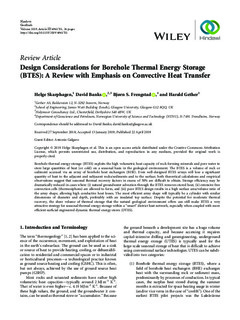| dc.contributor.author | Skarphagen, Helge | |
| dc.contributor.author | Banks, David | |
| dc.contributor.author | Frengstad, Bjørn S. | |
| dc.contributor.author | Gether, Harald | |
| dc.date.accessioned | 2020-02-07T07:35:41Z | |
| dc.date.available | 2020-02-07T07:35:41Z | |
| dc.date.created | 2019-04-24T09:21:45Z | |
| dc.date.issued | 2019 | |
| dc.identifier.citation | Geofluids. 2019, 2019:4961781 1-26. | nb_NO |
| dc.identifier.issn | 1468-8115 | |
| dc.identifier.uri | http://hdl.handle.net/11250/2640134 | |
| dc.description.abstract | Borehole thermal energy storage (BTES) exploits the high volumetric heat capacity of rock-forming minerals and pore water to store large quantities of heat (or cold) on a seasonal basis in the geological environment. The BTES is a volume of rock or sediment accessed via an array of borehole heat exchangers (BHE). Even well-designed BTES arrays will lose a significant quantity of heat to the adjacent and subjacent rocks/sediments and to the surface; both theoretical calculations and empirical observations suggest that seasonal thermal recovery factors in excess of 50% are difficult to obtain. Storage efficiency may be dramatically reduced in cases where (i) natural groundwater advection through the BTES removes stored heat, (ii) extensive free convection cells (thermosiphons) are allowed to form, and (iii) poor BTES design results in a high surface area/volume ratio of the array shape, allowing high conductive heat losses. The most efficient array shape will typically be a cylinder with similar dimensions of diameter and depth, preferably with an insulated top surface. Despite the potential for moderate thermal recovery, the sheer volume of thermal storage that the natural geological environment offers can still make BTES a very attractive strategy for seasonal thermal energy storage within a “smart” district heat network, especially when coupled with more efficient surficial engineered dynamic thermal energy stores (DTES) | nb_NO |
| dc.language.iso | eng | nb_NO |
| dc.publisher | Hindawi | nb_NO |
| dc.rights | Navngivelse 4.0 Internasjonal | * |
| dc.rights.uri | http://creativecommons.org/licenses/by/4.0/deed.no | * |
| dc.title | Design considerations for borehole thermal energy storage (BTES): A review with emphasis on convective heat transfer | nb_NO |
| dc.type | Journal article | nb_NO |
| dc.type | Peer reviewed | nb_NO |
| dc.description.version | publishedVersion | nb_NO |
| dc.source.pagenumber | 1-26 | nb_NO |
| dc.source.volume | 2019:4961781 | nb_NO |
| dc.source.journal | Geofluids | nb_NO |
| dc.identifier.doi | 10.1155/2019/4961781 | |
| dc.identifier.cristin | 1693591 | |
| dc.description.localcode | Copyright © 2019 Helge Skarphagen et al. This is an open access article distributed under the Creative Commons Attribution License, which permits unrestricted use, distribution, and reproduction in any medium, provided the original work is properly cited. | nb_NO |
| cristin.unitcode | 194,64,90,0 | |
| cristin.unitname | Institutt for geovitenskap og petroleum | |
| cristin.ispublished | true | |
| cristin.fulltext | original | |
| cristin.qualitycode | 1 | |

